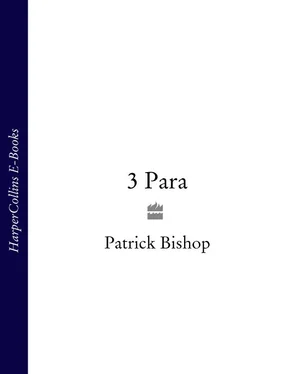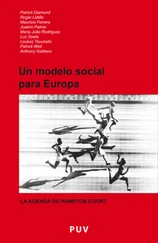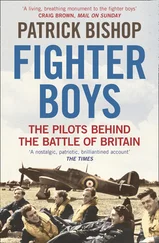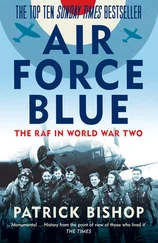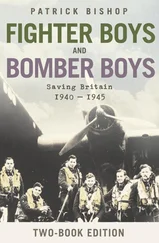The Parachute Regiment was one of the youngest in the British Army. But in its short life it had developed a strong identity and a powerful sense of its own capabilities and worth. The formation of a permanent airborne force was Churchill’s idea. The new regiment was intended to bring together the fittest, most motivated and resourceful men available. Its purpose was to cause the maximum damage to the enemy with minimal or no support. It was expected to operate behind enemy lines undaunted by overwhelming superior enemy forces. Its spirit was summed up in its motto, Utrinque Paratus – Ready for Anything.
The first British airborne assault took place in February 1941 when a small band of daredevils jumped into southern Italy and blew up an aqueduct. In the remaining four years of the war the Paras built a tradition as illustrious as that of many of the ancient regiments they fought alongside. They were in North Africa and took part in the invasions of Sicily and Italy. They played a key role in the Normandy landings, notably at Merville, where they knocked out a gun battery protected from air attack by 12-foot-thick concrete, which threatened the invasion fleet.
They were at the heart of the most famous airborne operation in history, Market Garden. The Paras, alongside two airborne divisions of Americans and one of Poles, were dropped 100 miles behind the German front lines to clear a corridor across the Netherlands for the advancing Allied armies. The 10,000-strong British 1st Airborne Division was all but wiped out and the key bridge at Arnhem it was tasked to capture remained in German hands. But the episode established an imperishable reputation for courage, resolution and coolness that was celebrated in the film A Bridge Too Far . During the Suez crisis in 1956, 660 paratroopers dropped into El Gamil airport in darkness, securing it in the face of heavy opposition.
Memories of Merville, Arnhem and Suez still colour the Para ethos. New recruits might not know the name of the last prime minister but one, but by the time they finish their training they will be fluent in the history of the regiment. This pride in the past provides a reservoir of spiritual strength to draw on in hard times. ‘We are here to uphold something that has gone before,’ said John Hardy, the 3 Para RSM. In nasty moments in Helmand, when fortitude was flagging, he would remind his men that their performance was under scrutiny, asking them, ‘The blokes who went through the war, through Arnhem – what would they think?’
The path to the Parachute Regiment is long and hard and strewn with obstacles. After an initial three-day selection, would-be paratroopers begin six months’ basic training at the army training centre at Catterick, a sprawl of brick blocks, plonked down in the rolling farmland of North Yorkshire. Inside its gates someone, somewhere always seems to be barking a command. No one walks and everyone marches. A surprising number are hobbling, poling themselves along on crutches. The chances are they are Para candidates whose limbs have failed to withstand the rigours of the course.
The training washes out the unfit and the unsuited. The final selection, for officers and men, is made at Pegasus Company – known as ‘P’ Company. It is designed to sort out whether or not you have the Para DNA. It is a rite of passage that those who have endured still talk about with pained awe years afterwards. It is above all a test of determination. ‘The thing about P Company, which is difficult to explain to anyone who hasn’t done it, is that it’s not really a physical test, it’s a mental test,’ said Captain Hugo Farmer, who won a Conspicuous Gallantry Cross in Helmand. ‘If you want it and you are determined enough, you will pass it. You have to have a reasonable degree of fitness, obviously, or you will fail early on. But it is people who are mentally tough that are wanted. That’s the most imporant thing.’
P Company lasts three weeks. The first two are taken up with daily battle marches with kit, squad runs and intensive circuit training sessions designed to physically exhaust candidates before the final ‘Test Week’ begins. This starts with a stint on the Trainasium – an aerial assault course over high, narrow walkways and a tower built out of scaffolding and wood. Candidates are ordered to do an ‘illusion jump’, which means running along a plank suspended 30 feet up and launching themselves at a cargo net 15 feet away. In this way, the instructors test whether the candidate can handle heights. It also tells them whether he will throw himself from a height without question. ‘It takes quite a lot to run up to the end of the plank and launch yourself off not knowing whether you will make that net or, if you do, if you will bounce off,’ remembered one survivor.
This is followed by a 10-mile battle march carrying full kit and weapon. The next day starts with a 2-mile steeplechase and three circuits of an assault course. Then comes the log race in which teams compete to carry a telegraph-pole-sized piece of timber over a difficult cross-country course. Anyone who fails to keep up can expect to flunk the course. Day Three begins with a 2-mile best-effort run with kit. The afternoon is given over to ‘milling’. This involves two candidates standing toe to toe, slugging it out for sixty seconds. The fighters are not allowed to defend themselves, only punch. They wear heavy, 16oz gloves and protective headgear, but many still finish the bout spattered in blood.
The candidates get the weekend off to recover. When they return, they are sent off on a 20-mile endurance march with full kit, weapon and helmet. The course ends with another cross-country race. This time the teams carry a ‘casualty’ on a stretcher. About half of those who try fail P Company. Many drop out through injury. Women have attempted it, but none has yet passed.
The successful candidates go next to RAF Brize Norton, where they undertake eight increasingly difficult parachute jumps, the last made in full kit at night-time.
Parts of the selection process seem at first glance to be anachronistic and out of tune with what is required of a modern professional army. ‘Milling’ is a term that dates back to the days of bare-knuckle prizefighting, and the Paras is the only regiment in the British Army to practise it. Arriving on the battlefield by parachute is almost as bizarre nowadays as turning up on a horse. The Paras, however, have an almost mystical belief in the value of jumping. They tried to get permission for a classic parachute drop operation in Helmand. The idea was rejected by higher authority as charming, but impractical.
Their loyalty to these habits is based on the belief that they have an intangible worth far greater than their apparent practicality. ‘When you are on the log race and and you have got 200 metres to go and you are absolutely knackered you do not give up,’ said Lieutenant Andy Mallet, an accountancy executive in his former life. ‘If anything you go faster. When you are in the ring and you are milling someone and they are bigger than you, you don’t give up, you keep milling. It’s that ethos that nobody else has.’
The final test of courage and commitment is the jump. At the end of training ‘your initial reaction is to do whatever you are asked, so when you are standing in the door of the aircraft and you see the green light go on and you are given “green on – go”, you go. It’s that principle that we take forward in everything we do.’
Jumping in the Parachute Regiment is not the same as sports parachuting. It involves, according to Stuart Tootal, throwing yourself ‘out of a perfectly serviceable aircraft at night with a heavy container of equipment often weighing upwards of a hundred pounds strapped to your legs, with another eighty or so people trying to leave the same aircraft … the hazards of doing that are quite significant’.
Читать дальше
